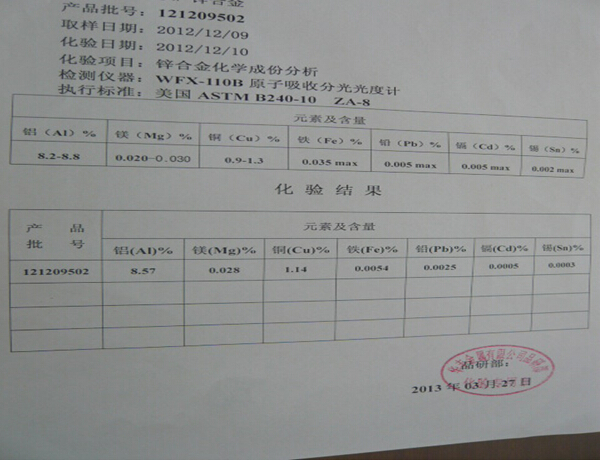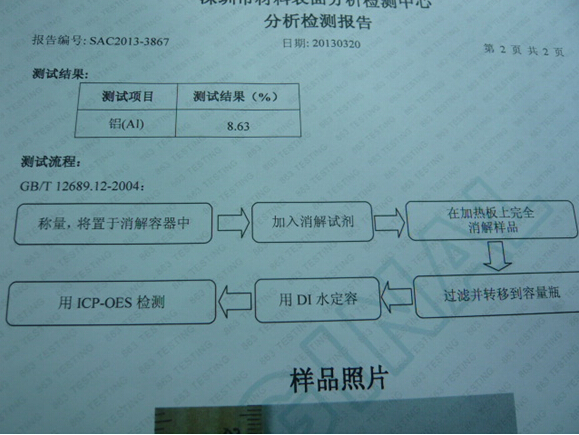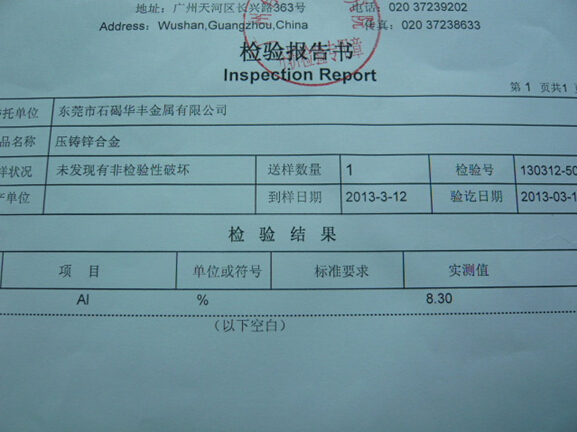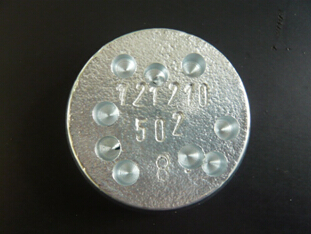
Liang Huancao, Chairman of Dongguan Shijie Huafeng Metal Co., Ltd
Abstract: This paper discusses the factors that our company sent Zamak-8, a zinc alloy for die casting, for external inspection, and the negligence of the testing staff in the process of sampling, sample preparation, verification, control and management in the testing organization, resulting in excessive errors in the composition and content data of aluminum element in the testing results; The wrong judgment that harms the qualified products of our inspection party and the trust discount of the external inspection agency also greatly affect the notarization of the inspection agency itself; The article clarifies the correct management and practice of laboratory testing process methods, and analyzes the causes of data errors.
Keywords: ingot segregation, aluminum ICP-OES detection, atomic absorption detection, assay, sampling, sample preparation, verification, control data
In the period of rapid development of electronics and software technology, manufacturers and consumers have constantly improved their quality requirements and quality awareness. The guarantee of industrial materials is the key to the quality of end products. As far as the hardware processing industry is concerned, the inspection methods of material element composition include atomic absorption spectrophotometer, plasma emission spectrometer and ICP-OES detection method; The instrument and equipment technology has high accuracy, fast detection speed and convenient operation, which is also worthy of the trust of the business. However, in a laboratory or testing center with advanced technical hardware and software, negligence in some details of control and work, such as incorrect working methods of sampling, sample preparation and other inspections, will cause great errors in the test data results; The different data will cause confusion for the inspection party to use as the product voucher, lose the significance of the legal basis, and also cause economic disputes in business; In addition, it will cause great harm to both the sending party and the testing party if the testing agency loses trust in its own notarization; The testing party should strictly enforce the process control and management methods to ensure the accuracy of the data. It should not only seek the expected economic benefits in business, but also be irresponsible to the customers for inspection and lose business ethics. The following takes the aluminum element test result data of more than 8 authoritative testing companies of Zamak-8 zinc alloy for die casting as an example, describes the factors of test data error and demonstrates the correct operation method, and jointly discusses the far-reaching significance of the inspection work.
The zinc alloy Zamak-8 for die casting is a zinc alloy raw material with high aluminum composition. The production complies with the American standard ASTM B240-10. The range of elements and composition content is shown in Table 1; Zamak-8 has a large aluminum composition segregation during the production process of smelting ingot, which means that the aluminum composition content of ingot material at different times during ingot casting has different degrees of segregation, and can only be controlled within the standard content range, which cannot ensure the absolute uniformity of the composition; As we all know, the density of aluminum is more than twice as low as that of zinc, and aluminum molecules are more active than zinc molecules and easily float on the upper layer of molten metal, which naturally segregates in the process of insulation, feeding and ingot casting; The segregation of aluminum content is also different in the cooling shrinkage lagging part of the mold; Even if the ingot is cast with water in the stirring, segregation still exists. In that case, the representativeness and scientificity of sampling must also be considered in sampling and sample preparation for component analysis. The following is a case study of the difference between our company's self inspection and sending three external inspection companies' laboratories to test the aluminum content data of the same sample, demonstrating the factors that may be overlooked in the work process of the external inspection companies.
American standard ASTM B240-10 ZA-8
| Elements and content |
||||||
| Aluminum (Al)% |
Magnesium (Mg)% |
Copper (Cu)% |
Iron (Fe)% max |
Lead (Pb)% max |
Cadmium (Cd)% max |
Tin (Sn)% max |
| 8.2~8.8 |
0.02~0.03 |
0.9~1.3 |
zero point zero three five |
zero point zero zero five |
zero point zero zero five |
zero point zero zero two |
Table 1
The following figures 1, 2, 3 and 4 are the results of the testing of the same zinc alloy Zamak-8 sample by four companies. Let's first look at the use of testing equipment by each company:
1. Huafeng Company: use atomic absorption spectrophotometer to detect (the results are shown in Figure 1);
2. A company in Shenzhen 1: use ICP-OES detection method (the results are shown in Figure 2);
3. A company in Shenzhen 2: used ICP-OES detection method (the results are shown in Figure 3);
4. A research institute in Guangzhou used plasma emission spectrometer to detect (the results are shown in Figure 4).
The data in Figure 2, Figure 3 and Figure 4 are the test results of a third-party inspection agency, and the composition content of aluminum element can be seen only:
1. Huafeng Company detected 8.57% of aluminum (Al), and a Shenzhen company 2 detected 8.63% of aluminum (Al). The data of these two detection results are very close, and our company believes that these two values are the correct composition content;
2. A company in Shenzhen measured 9.89% of the data of aluminum (Al), and a research institute in Guangzhou measured 8.3% of the data of aluminum (Al), which corresponds to the data range of the American standard ASTM B240 as shown in Table 1. The aluminum composition in Figure 2 has exceeded the upper limit of the standard by 1.09%, and the value in Figure 4 is closer to the lower limit;
The same sample is inspected by different companies, and the results are incorrect. In addition to the allowable error on the equipment, we believe that only when there is an oversight link in the test process, will the test result have a great error; It can be seen from the following figure that the test results of a company in Shenzhen 1 are incorrect and there is negligence in work. Such report values are provided to our company only due to lack of strict control, which is also irresponsible and sloppy.
Workers who often work in the laboratory are surprised that the same zinc alloy Zamak-8 sample has such amazing error results from different companies. In this process, the management work was a little cautious. It was found in time and re sampled for verification, so that the error information could not be transmitted to the inspection party due to the test error; Fortunately, our company has its own laboratory, and the staff have strong professional knowledge. They are familiar with the manufacturing process and element content of zinc alloy materials and sent to several external inspection companies for verification, which ensures that the wrong data does not flow to our customers. As a result, we have to worry about the data of the testing party and have a skeptical attitude. But the innocent thing is that as the testing party, some customers do not have the common sense and experience of raw material element content. Any value given by the testing party is regarded as qualified, which is a strong legal basis and very reliable; Therefore, the quality verification and report issuance of the testing agency need to be strictly controlled to make the merchants trust and rest assured. In that case, where did a company in Shenzhen and a research institute in Guangzhou work, leading to such large errors in data, we need to first clarify the correct way and management of the testing process.

Figure 1 Self inspection data of Huafeng Company

Figure 2 Test data of a company in Shenzhen

Figure 3 Test data of a company in Shenzhen

Figure 4 Test data of a research institute in Guangzhou
◎ Instructions for normal laboratory work:
1. Sampling method: cast samples must be representative to prove the accuracy of batch materials; The common practice is to take three casting samples of alloy melt from the same furnace at different discharge periods for inspection, and take the average value of the composition content of the three samples for testing. The data fully reflects the accuracy of the raw material. With reference to the upper and lower limit of the element composition range of the standards implemented by the production model, the average value of the composition content is within the limited range, and is recognized as qualified alloy raw materials.
2. Sample preparation: The sampling and preparation method of raw material samples is very critical and should be representative. When testing and sample preparation, samples should be taken as many front and back sides as possible, and the surface oxide layer needs to be removed. Generally, the steps are as follows:
2.1 Clean the sample preparation tools and equipment to ensure that there are no other residues;
2.2 Remove the oxide layer on the surface of the sample;
2.3 Generally, two or three different positions are taken for each sample, and both sides are sampled;
2.4 Take 50~100g samples as required, cut them into pieces and mix them evenly. Weigh 50~100g samples and shake them evenly with fixed weight after melting;
2.5 During the test, 5~10g of samples shall be taken as required.
3. Double person and double copy inspection comparison method: for each sample, two people use the same equipment and method to repeat the inspection, and each person makes double copies. The results are compared with four groups of data to verify the accuracy of element content; Accuracy: If the data between two persons cannot reach the same level, a third person is required to re test and verify; It should be noted that revalidation should be carried out from a series of working processes such as sampling and sample preparation. It should not be carried out in the same way as the previous parent sample. The drilled samples should be retested from the original source, not from an intermediate link.
4. Error elimination method: for alloy testing, a standard management sample should be paired, and the composition of this management sample is very close to that of the tested sample; This management sample is used to verify the consistency in the process of sampling, sample preparation, weighing and testing, and reduce the error in this series of operations; In order to reduce the detection error, the preparation of the standard should be matched with the main interfering elements of the tested sample, that is, some main elements are artificially added to the standard, so that the main elements of the standard solution and the tested sample solution are similar.
5. Standard sample blank management: use sample blank, standard blank and purified water blank to eliminate the interference of drugs and standard instruments. During the long-term use of the equipment, the readings will shift, so it is necessary to take standard samples regularly for inspection and verification. The product inspection for more than three times is similar to the standard sample readings, depending on the integrity of the equipment.
6. File verification management: when issuing the report, carefully check the data of each work step to avoid negligence, error and omission. If there is a large error in the data, the relevant laboratory personnel shall communicate, check, verify and confirm, and submit the accurate data report.
◎ Analysis of data error factors
In terms of work, strict inspection methods and management of the above ladder type is the key to ensure that the submitted test results avoid data errors. With such a work program and control guarantee, it is not difficult for us to find out the cause of excessive error in aluminum content of the Zamak-8 sample submitted by our company. The inspection data of a company in Shenzhen and a research institute in Guangzhou by an external inspection agency should be neglected in the following aspects:
1. Sample preparation error: the sample is cast by natural gravity, as shown in Figure 5. The aluminum composition of the upper and lower surfaces of the sample is
If there is some segregation, the aluminum molecules are relatively active. When casting the sample, the aluminum is easy to float on the upper surface, and the segregation is relatively large. When taking samples, the analyst drilled the upper plane near the center with too much zinc chips, and did not remove the sample skin oxide layer, thus obtaining the sample with high segregation;
2. Lack and error of process method: the double person double copy method is not achieved, and this link is that two testers use the same equipment and method
Re inspection, if this step is used to verify the comparison, it is easy to find the difference of data; If there is any error data, the two people cannot pass the test unanimously, and a third person will re test and prove it to ensure the accurate data of the sample. This is a lack of process methods;
3. File monitoring management is irresponsible: after the inspection report is issued, it fails to compare with the standard to find the data error, and carefully review
During the inspection process, we rechecked the doubtful data in the report, which led to the issuance of wrong data in the test report and submitted it to our company.


Lower plane of casting sample Upper plane of casting sample
Figure 5 Huafeng Zamak-8 sample
Conclusion: From the above cases, it can be seen that the negligence of each work link in the inspection process, the data read, will cause great harm to the inspection party, and the economic disputes and losses caused are incalculable, and the inspection party will not shirk the legal responsibility; The sending party also needs to have a knowledge of the basic composition of the materials used in its own products. Each time it receives an external inspection report, it should check whether there are any abnormal questions about the content data of each element compared with the previous data submitted for inspection, and find and follow up problems in a timely manner; Increase material awareness, prevent false information in external inspection, and achieve self accurate measurement. The view of this paper is not to blame any testing company or institution, but to arouse our professional laboratory staff to attach great importance to the importance of our perspective and serious work attitude; It also reminds the merchants to strengthen the awareness of external inspection data of materials. In particular, the example in the article section is an alarm to the inspection organization and the workers from the self testing work. Laboratory management should not only set up a scientific control program, but also have a strict working attitude to ensure the accuracy of the data content in the report and maintain a neutral balance. In a word, the internationally and nationally recognized inspection institutions are a ruler and a balance. Only by keeping the water level, doing the work in detail, and accurate data results can customers be assured and trusted, and become a more powerful legal basis.

About the first author: Liang Huancao, male, born in 1951 in Hong Kong, master of engineering materials, and expert in metal hot forming and die casting technology; Vice Chairman of the National Foundry Standardization Technical Committee (SAC/TC54/SC4); Member of the National Technical Committee for Standardization of Foundry Machinery (SAC/TC186/SC2); Member of Die Casting Technical Committee of China Foundry Society.
Copyright © Copyright 粤ICP备14053330号 Haixing Group International Co., Ltd